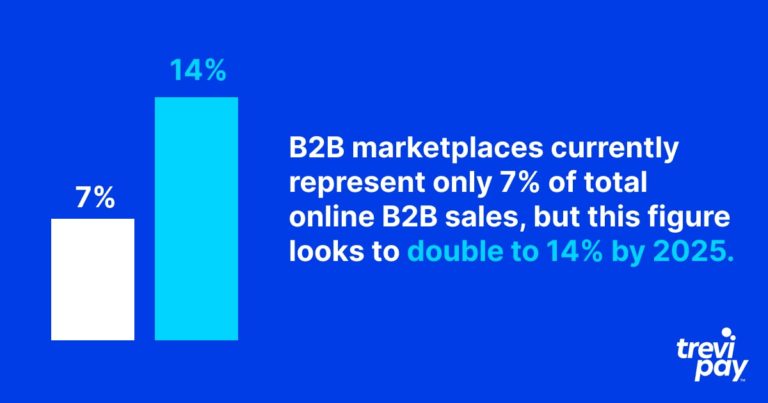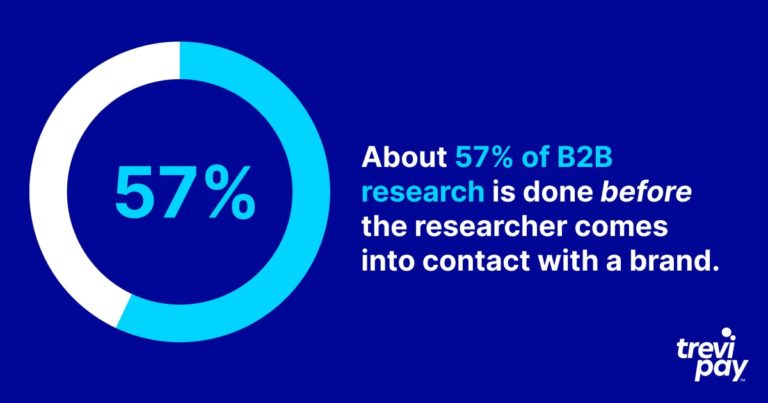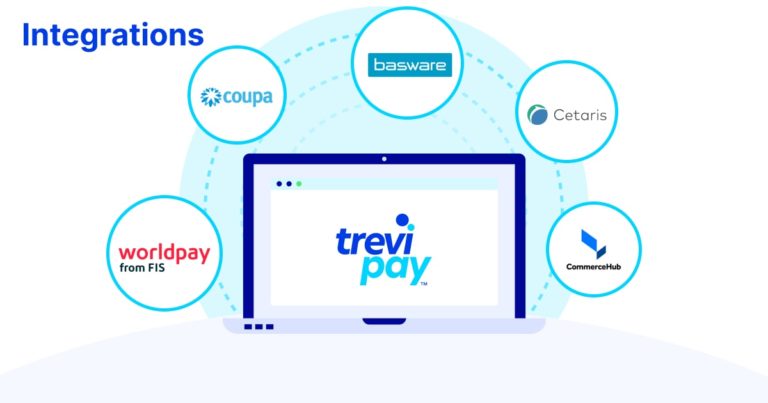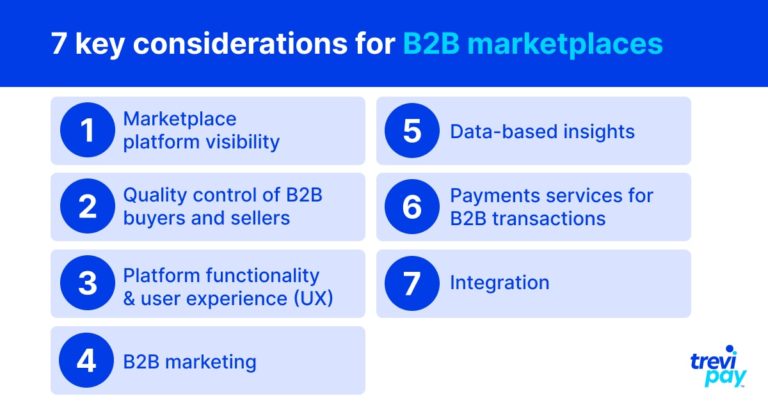B2B marketplaces are still in their infancy. And like any infant, this means they are growing and changing fast.
They currently represent only 7% of total online B2B sales, but this figure looks to double to 14% by 2025.
A key driver of this shift is an increasing demand from corporate customers looking for a powerful second sales or supply channel.
Building the best possible B2B marketplace to meet this need requires knowledge, experience and broad perspective of how they work.
Let’s take a deeper dive into B2B marketplaces and evaluate the seven factors that can determine their success.

Defining the B2B marketplace
We previously explained what a B2B marketplace is. So, let’s keep our definition brief here.
Broadly speaking, a B2B marketplace is anywhere that businesses can trade exclusively with other businesses. Today, most of these are multi-vendor online marketplaces.
They vary in structure as much as business-to-consumer (B2C) marketplaces (think of the differences between Amazon, Etsy, and Booking.com, for example).
They also range in scope, from local to global or industry-specific or multi-industry.
7 key considerations for B2B marketplaces
As with many other types of digital innovation, especially in eCommerce, B2B marketplaces will continue to change as demand, availability and technology develops.
It is their dynamic and diverse nature that makes them interesting and exciting.
While there is currently no standard business model, certain trends are clear.
Below are 7 key considerations for B2B marketplaces from the perspectives of marketplace creators.
1. Marketplace platform visibility
One of the first things to consider when launching a B2B eCommerce marketplace is its visibility. This will be a crucial to its growth and eventual size.
It’s not just consumers that search for goods and services online. Google estimates that 89% of B2B researchers use the internet at some point during their research process and of these, 90% specifically use search.
And about 57% of the research is also done before the researcher comes into contact with a brand.
B2B marketplaces are only as strong as the buyers and sellers who use them. Therefore, they need to be highly visible across multiple terms in search to gain customers. If you are setting up a B2B marketplace, you will need to put time and money into SEO to make sure yours can be found.
But visibility of a marketplace may not only be online. A presence in B2B publications, at industry events, and across social media are also important to attract and build up a viable user base.
These channels help associate a marketplace with relevant brands. They also help build trust, which is essential for a corporate that’s considering using a new marketplace.

2. Quality control of B2B buyers and sellers
High visibility alone isn’t enough to ensure the success of a marketplace.
One of the main benefits of a B2b marketplace is that it forms a readymade network for businesses. The quality of a network is often as important as its size.
Chinese B2B marketplace Alibaba famously purged many counterfeit vendors from its platform several years ago. This raises a broader question for B2B marketplaces owners: the vetting of vendors and their products and services.
Barriers to entry are a primary way of making sure only the right businesses join. A simple technique is charging a sign-up or membership fee as part of the onboarding process.
But if the process is too time-consuming or complex, some businesses will be driven away. This could slow the momentum of growth for the marketplace and undermine its success.
Due diligence and secure processes that protect users are also essential responsibilities of B2B marketplace owners.
There is a need to strike the right balance between certifying high-quality buyers and sellers and having the right quantity of them.
3. Platform functionality and user experience (UX)
Attracting sufficient high-quality buyers to a B2B platform is a tough task. Keeping them there is even harder.
The user experience (UX) of a B2B marketplace is critical to customer retention.
After all, B2B buyers and sellers will be users of consumer-focused eCommerce platforms. They are likely to favour B2B platforms with similar functionality and great UX.
The whole conversion process from browsing to becoming buyers needs to be seamless and efficient. This will, of course, come down to design and software.
Just like in the world of eCommerce outside of B2B, some basic principles apply:
- how information on products and services is presented
- how intuitive and customisable the platform is
- how quickly results appear
- how relevant information is ordered
- how easy comparisons can be made
- how visible reviews and rating are
One key component is the internal search function. This isn’t something B2B marketplaces are likely to master immediately -it will be an ongoing project. Marketplaces can learn an important principle from Google itself here, which updates its algorithms 500 – 600 times a year.
AI and automation tools are also extremely useful. These cover everything from support chatbots to product recommendation capabilities.
4. B2B marketing
B2B marketing is very different from what we see in the consumer world (B2C).
In a B2B environment, buyers are often motivated by information rather than emotionally-centred messaging commonly used in consumer marketing.
Many marketplaces allow sellers to use customisable storefronts to express brand identity, just like websites.
But unlike a website, buyers will value the ability to compare goods and services side by side from competing suppliers. Being able to optimise these features will improve a platforms’ look and feel as well as stickiness.
5. Data-based insights
Platforms with tools that supply data to sellers and buyers will likely outperform those without it. After all, data drives sales.
Unlike B2C, most B2B purchases are planned in advance and justified before being approved. Data often provides the best evidence to make a case with this.
Some of these insights can be taken away and applied to other areas of customers’ businesses.
For example, they may realise that the demand for a certain product or service appears to be higher amongst businesses.
This is particularly useful information to have for their sales team to have when dealing with businesses outside of the platform.
6. Payments services for B2B transactions
Payments processes on B2B marketplaces can be difficult.
They are generally larger and more complex than B2C sites, require more negotiation of terms, approval by multiple parties and instalments of payments over a longer time.
Being able to facilitate this is the responsibility of the platform. To optimise their success, third party sellers need to be supported by a seamless and secure transaction process. Enabling buyers to pay via invoice and request Net 30 terms for purchases should be part of this.
As with UX issues generally, the key to good payments is speed and a frictionless experience. At TreviPay, for example, we offer automated credit decisions on credit lines of up to $2500,000 USD (£225,000 approx.) within 30 seconds.
The application and buying process can be seamlessly integrated into the purchasing experience of the marketplace. This is often known as ‘embedded payments’.
7. Integration
Being able to easily integrate with multiple software solutions can improve the marketability and customer retention rate of a platform.
Using an API-first approach, TreviPay integrates into ERP systems. This alleviates the need to add another technology for the A/R team to manage, while automating many manual processes.
TreviPay’s payment integrations work seamlessly with these popular systems, among others:
- Worldpay from FIS
- Baseware
- Cetaris
- CommerceHub
- Coupa

Integration with software solutions will not only directly benefit the end user, but will also help sway decisions to join or keep using a marketplace.
With integration capabilities, objections based on incompatibility with businesses’ other tools turn into selling points.
It might also open up partnership potential with other software suppliers.
This may seem like ambitious thinking for B2B marketplaces in their early phases but the rapid growth within this field makes it a sensible consideration.

Conclusion
There are now hundreds of new B2B industry-specific enterprise marketplaces and their membership numbers are growing fast. If you are thinking of creating a B2B marketplace, there really is no time like the present.
But in order to grow and thrive in this increasingly crowded market, B2B marketplaces need to be visible. Most B2B research is done via search at some point – appearing in those results is essential.
The quality of a B2B marketplace platform depends mainly on the companies buying and selling on it, and you need to take the first steps to successfully start your own B2B marketplace.
Functionality and UX will significantly impact customer experience and retention. Business buyers and sellers increasingly expect the same kind of intuitive design and tools that they experience on consumer marketplace platforms.
B2B marketing generally is driven by information as opposed to emotion. B2B marketplaces should provide the space and tools for B2B brands to express themselves. And they should make sure that insights from data are also available to help inform future decisions.
Payments are an essential feature in B2B eCommerce, where embedded payment solutions such as offering trade credit are needed.
Integration with other digital solutions is also important. Companies’ workflows might be inextricably linked to certain software solutions – compatibility with these could significantly impact vendors’ likelihood of signing up or ongoing use.






